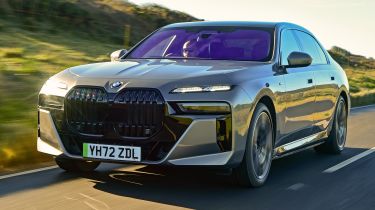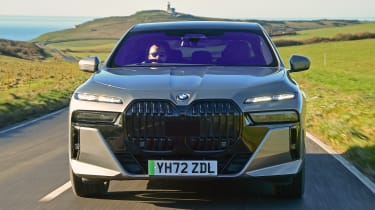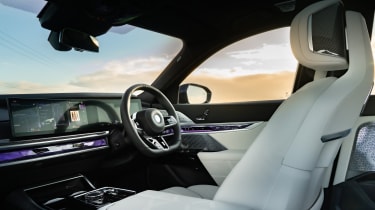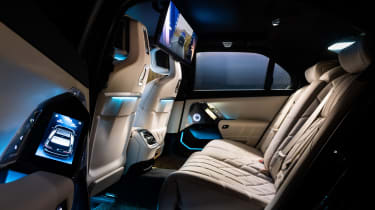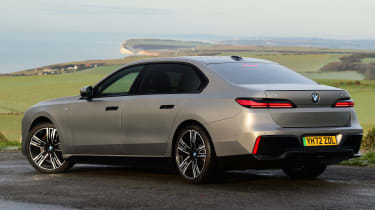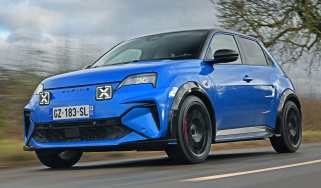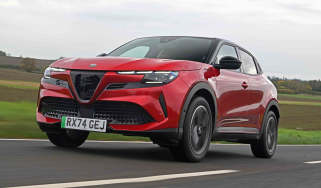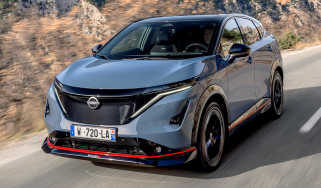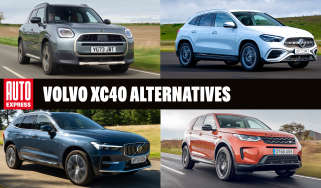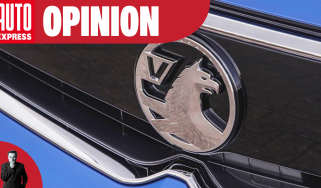BMW i7 review
You’ll either love or loathe the styling, but the BMW i7 is a supremely comfortable and capable luxury EV

Electric power has come to the luxury car market in the form of the BMW i7, which follows the brand’s decision to offer both hybrid and pure EV versions of its long-running BMW 7 Series luxury saloon. The i7 is a thoroughly modern take on the traditional limousine and is effectively the flagship of the range, prioritising supreme comfort and refinement. It is packed with advanced technology, most of which works very well. The styling is certainly bold and might be too aggressive and obvious for some, but there’s no denying that BMW has created a fine luxury car.
Our choice: BMW i7 eDrive50 M Sport
About the BMW i7
BMW may well have embraced the future with its latest BMW 7 Series, but it’s hedging its bets for now with both petrol-hybrid and fully electric models. It’s the latter model – known as the BMW i7 – we’re concerned with here, which will come in three main flavours. There’s an entry-level eDrive50 with 449bhp, the more powerful, four-wheel drive xDrive60 with 537bhp, and the xDrive M70 that constitutes the performance offering in the range, delivering 650bhp.
In the UK, there are two main trim levels: Excellence, which is the more comfort/luxury orientated trim, and the familiar M Sport, which as the name suggests is on the sportier side and features bigger wheels and racier styling. Both of these trims can be upgraded to ‘Pro’ specification, at a cost of just under £18,000, which includes the vast majority of the options available for the standard car – as you’d expect at that price.
BMW’s 7 Series has always been a fundamentally sportier take on the luxury limousine market, particularly when compared to the Mercedes-Benz S-Class, but the i7 looks to combine comfort and driver appeal like no 7 Series before it. Mercedes-Benz’s EV challenger in this market segment is the Mercedes EQS, which comes in standard guise and with a performance Mercedes-AMG EQS 53 variant. There are also plug-in hybrid versions of the more traditional S-Class. So far, Audi only offers a hybrid version of its Audi A8 limousine, with no pure EV alternative.
Electric motor, performance & drive
The BMW i7 may weigh a hefty 2.7 tonnes (especially in four-wheel drive forms) and have a 5.4-metre-long body, but the optional rear-wheel-steering system helps to make it far more agile than might be expected, with a noticeable pivoting feeling in tighter turns as the back wheels turn in the opposite direction to the fronts. This also drastically reduces the turning circle, making for more effortless low-speed manoeuvres. At higher speeds, the rear wheels turn in tandem with the fronts to aid stability.
More reviews
Despite the use of this system and a variable-ratio steering set-up, it’s easy to place the i7’s vast front end in corners. There’s very little in the way of feedback from the road surface, but that’s not really an issue in a car such as this. In any case, the weighting of the power assistance is well-judged and inspires confidence when traversing a twisty B road. What’s most noticeable is the lack of body roll: the i7 stays remarkably flat through corners, although it’s hard to tell how much of this can be attributed to the twin-chamber air suspension, or the optional 48-volt-powered active anti-roll bars
As is often the case with EVs, the battery pack sits nice and low in the car, giving a low centre of gravity, which helps negate some of the downsides of the i7’s weight. You can help to reduce the weight of the i7 by going for the rear-wheel drive eDrive50, which removes around 120kg of mass by ditching the front electric motor. That doesn’t suddenly translate into a meaningful boost in the i7’s already fine handling, or (as we’ll discuss later) an increase in driving range. What it does do is save you around £14,000, and it doesn’t diminish how the i7 drives, so we’d argue that it’s worthwhile having.
0-62mph acceleration and top speed
There’s a sporty element to the BMW i7, with even the entry-level 449bhp eDrive50 managing the 0-62mph sprint in 5.5 seconds, while the 536bhp four-wheel drive xDrive60 manages the same sprint in 4.7 seconds. Unless you happen to drive on a de-restricted Autobahn regularly, the higher 149mph top speed of the xDrive60 versus the 127mph maximum speed of the eDrive50 is of little importance in the UK, making the less expensive version our preferred option.
Those after the fastest i7 will likely gravitate towards the M70 xDrive with its Titanic 650bhp dual motor, four-wheel drive set up cuts the 0-62mph time down to 3.7 seconds and raises the top speed to a limited 155mph.
The only thing lacking when it comes to performance EVs is the feedback of noise while you accelerate, which is why it’s possible to accompany the ample acceleration of the i7 with sci-fi-like noise courtesy of film composer Hans Zimmer. Some will find that this feature suits the i7 remarkably well, but you can turn it off if you’d rather sit in silence.
Range, charging & running costs
All versions of BMW i7 feature a 105.7kWh (101.7kWh useable) battery pack which, according to the WLTP test cycle, provides between 338.6 to 386.5 miles of range, depending on spec and wheel size. We were surprised that the lighter rear-wheel drive eDrive50 doesn’t have the best range compared with the xDrive60, although a loss of less than 10 miles in the official range is hardly going to matter to most buyers.
However, we only managed a 2.6 miles per kWh return from the i7 when we tested it in four-wheel drive xDrive60 form, which equates to 265 miles of range based on the useable capacity – although the situation wasn’t helped by our test being in cold weather. Judging by our previous experiences with the i7, three miles per kWh should be within reach, and that would provide a fully-charged range of around 300 miles.
The maximum AC charging rate of BMW i7 is 11 kW, while DC power can be taken on board at a rate of up to 195 kW. This allows a nearly 30 minute top up from 10-80 per cent state of charge from a suitably fast ultra-rapid charger, while a typical 7.4kW home wallbox charger will take a little over 16 hours to fully recharge a flat battery.
One area where the i7 really scores? It qualifies for the 2 per cent Benefit-in-Kind (BiK) company car tax band compared to an Audi A8 55 TDi S-Line, which falls into the 37 per cent bracket. That’s a huge difference in the amount of tax payable, and unlike a more traditionally-powered limousine option, the i7 is exempt from road tax (VED) and the London Congestion Charge until 2025. If you’re running the car as a business, that’s a very big deal.
Insurance groups
All i7 models fall into the highest insurance category, group 50. However, that's almost expected at this price point, because the Mercedes-Benz EQS also sits in group 50.
Depreciation
The BMW i7 looks set to retain between 47 to 57 per cent of its OTR price after three years and 36,000 miles, which compares favourably with a ‘conventional’ hybrid 7 Series, with the M70 xDrive losing the most, and the eDrive50 Excellence maintaining the most.
It does better than the Mercedes EQS, which only manages 44 to 48 per cent over the same period.
To get an accurate valuation on a specific model check out our valuation tool...
Interior, design & technology
Any discussion of the BMW i7 interior has to start with the basic task of opening the door. The i7 has the option of automatic doors, but we’ve found their operation to be a little unreliable at times. On the inside of the back doors, there are two small touchpads that rear-seat passengers must use for myriad functions including climate control and seating position. While easy enough to navigate, they could do with being a little more responsive.
Occupants enjoy a lot of space in the rear of the cabin, helped by the fact that the i7 is even bigger than the previous-generation ‘G12’ long-wheelbase 7 Series. The only downside is a broad transmission tunnel running through the middle – inevitable given this platform is shared with the ICE-powered 7 Series. Up front, there’s the ‘BMW Interaction Bar’ spanning the dashboard and onto the inner door panels, which serves three roles. Firstly, it displays fancy ambient lighting graphics based on different themes, such as ‘efficiency’ and ‘sport’. Secondly, it can provide visual feedback for safety reasons (a proximity warning, for example). Thirdly, it also acts as a surface for come controls, including the front and rear window demisting buttons.
You’ll find the hazard light button in the middle, but ideally, it would be elsewhere. It requires a surprisingly hard push to engage or disengage, causing the plastic lens of the Interaction Bar to creak. It’s one of the few areas where we can question the quality of the car; in the main, the i7 feels like a very well-made and premium offering.
Sat-nav, stereo and infotainment
The infotainment system of the BMW i7 is dominated by the presence of the Theatre Screen, which is fitted as standard on the Excellence Pro and M Sport Pro models (a nearly £4,500 individual option on regular i7 trims). It’s a giant, 31.3-inch screen with 8K resolution that spans partway across the rear passenger compartment.
However, we were underwhelmed by the screen because there isn’t much content you can run on it that can take advantage of the width. Beyond BMW’s own demo videos, most TV series and films will have to be watched with massive black bars on either side, meaning each rear-seat passenger will need to turn their heads a fair way to see the content properly.
If you look straight ahead, the bezel of the screen unit itself is directly in your eye line. Two smaller screens may look less impressive but are far more practical, so you might be better off choosing the far cheaper option of tablet holders.
You can also upgrade to the Bowers and Wilkins Diamond Surround Sound system, which is available either in the Technology Plus pack (£5,775) or – wait for it – the near £30,000 Ultimate Pack. Also as part of this ‘everything, including the kitchen sink’ package is a hi-fi upgrade. Its sound quality is hugely impressive, giving a home cinema experience.
Otherwise, there’s every piece of modern connectivity and functionality you would expect from a premium manufacturer’s flagship model.
Practicality, comfort & boot space
Given its intended market, the BMW i7 is large, spacious and very comfortable – and can be made all the more so with the addition of either the Rear Comfort Pack or the Executive Pack, the latter turning the i7 into something akin to a living room on wheels.
Size
The BMW i7 is a large car at 5,391mm long, 1,950mm wide and 1,544mm tall. To put it into perspective, that compares with a Mercedes EQS at 5,216mm, 1,926mm and 1,512mm. Step down a class, and the current BMW 5 series measures 5,060mm long, 1,900mm wide, and 1,515mm tall.
Leg room, head room & passenger space
The BMW i7 is a supremely comfortable place in which to spend time. For rear seat passengers, the experience can be made all the more lavish by specifying either the £5,250 Rear Comfort Pack or the £11,025 Executive Pack. The former brings heated, massaging and multi-functional rear seats, whereas the latter provides the full luxury experience: executive lounge seating turns the i7 into a four-seater, with reclining seats and the ability to move the front passenger seat out of the way.
Boot space
With 500 litres of boot space, the BMW i7 should be more than capable of carrying the sort of luggage required by a luxury limousine. The i7 loses some practicality points against the Mercedes EQS, because that rival not only has 610-litres of luggage capacity, but it has a wider opening hatchback tailgate that’ll enable it to swallow taller items compared with the restrictive saloon tailgate of the i7.
Reliability & safety
The BMW i7 wasn’t included in the latest 2024 Driver Power ownership satisfaction survey, but the BMW brand scored a reasonable 14th place out of 32 manufacturers, with some clear distance between 25th-place Mercedes and 27th-place Audi. Owners praised the powertrains, infotainment system, ride and handling, safety features, and reliability of their BMWs. Running costs came in for some criticism, though.
The i7 (or the BMW 7 Series, upon which the i7 is closely related to) hasn’t been given a Euro NCAP rating yet, but with a very comprehensive suite of driver assistance and safety technology, it should be a very safe choice. If you are looking for a luxury electric car with an NCAP score, consider looking at the Mercedes EQS, which received the maximum five out of five-star rating in 2021.
Warranty
The BMW i7 benefits from a three-year, unlimited mileage warranty, with the battery receiving a separate eight-year or 100,000 miles warranty, whichever comes first. You’ll also get three years of roadside assistance coverage included.
Servicing
Servicing for the BMW i7 is required every 24 months or 12,000 miles, whichever comes first. BMW offers an inclusive service programme, which covers a minimum of the first four years of the car’s life for an upfront contribution. In addition, servicing can be paid for by a monthly fee, which in the case of the i7 is a reasonable £17.99 per month, compared to the 7 Series, which costs £30.99 per month.
